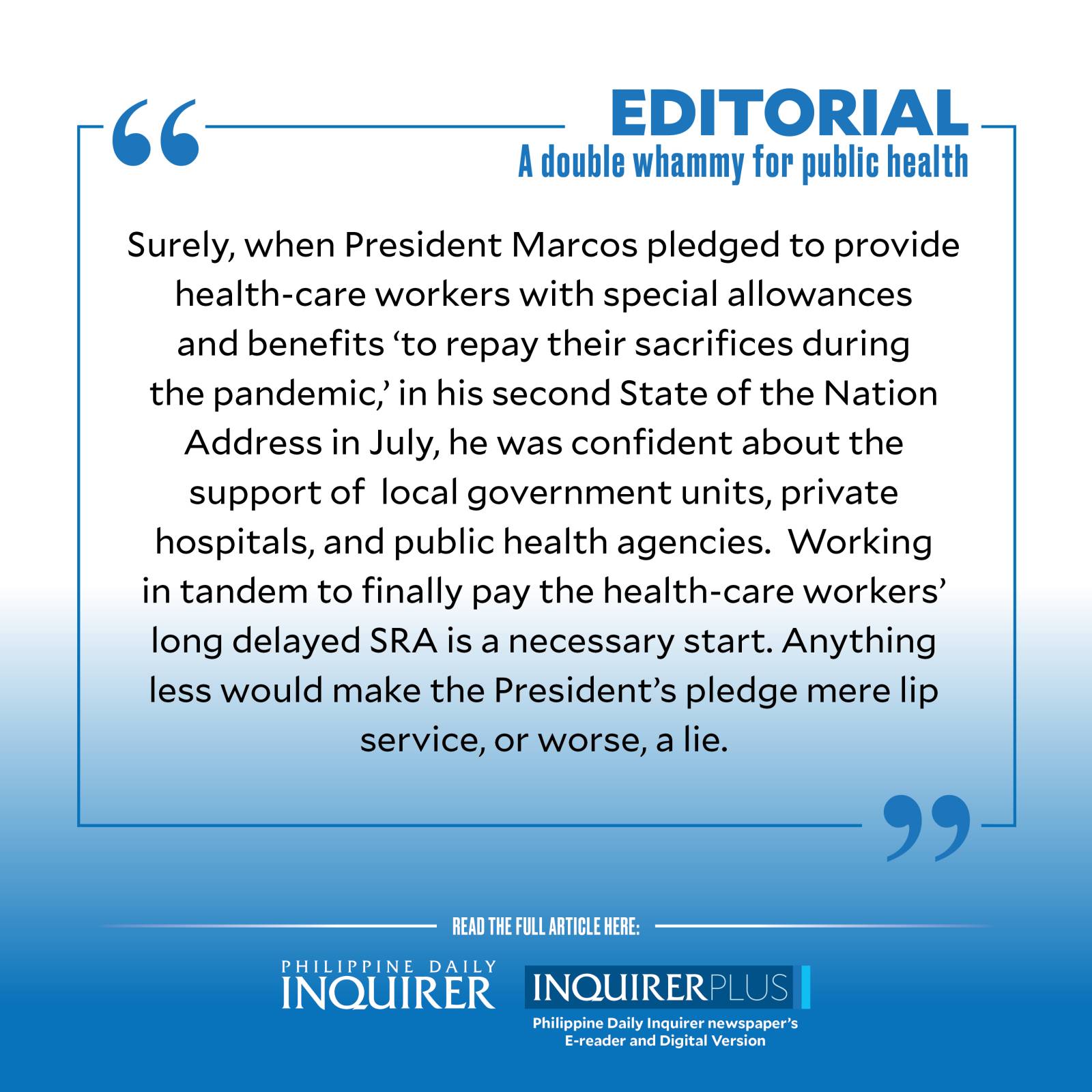
The national state of public health emergency over COVID-19 may have been lifted on July 21 this year, but an “all-time high’’ exodus of nurses abroad and the continuing scarcity of doctors are a double whammy that the country’s battered health system can ill afford.
Quezon City Rep. Marvin Rillo, vice chair of the House committee on higher and technical education, last week warned that 26,972 Filipino nurses took their first United States licensure test from January to September this year, more than double the 12,399 figure for the same period last year. With a 49 percent passing rate among Filipino nurses taking the exam for the first time, according to a US state board council, “[a] new wave of mass migration of [health] practitioners to America” is “looming,” Rillo said. This, in turn, could result in a nurse shortfall in the Philippines of 249,843 by 2030, he added, quoting the World Health organization (WHO).In 2019, the Philippine Overseas Employment Administration recorded 18,644 nurses going overseas, which may have resulted in a ratio of 8.2 nurses per 10,000 patients nationwide based on a 2020 study by the University of the Philippines (UP). The WHO-prescribed nurse-patient ratio is 10:10,000. The UP study also showed an average of 3.7 doctors per 10,000 population, well below the 10:10,000 ratio recommended by the global health body.The skewed distribution of health workers in the country has meanwhile resulted in remote or impoverished areas having little access to medical care, as shown in the September report of data and business intelligence portal Statista. The report indicated that the Davao region accounted for the lowest doctor-to-population ratio in 2022—1:40,680, as compared to Metro Manila’s 1:15,300 ratio.
There’s no denying that the meager pay in public and private hospitals has pushed our health workers to venture abroad, where their services are better appreciated and well-compensated. To remedy the mass migration, Rillo has proposed through House Bill No. 5276 a 75 percent raise in the monthly base pay of nurses in government hospitals—from P36,619 to P63,997.
Three years after Administrative Order No. 36 was issued on Nov. 16, 2020, which authorized the grant of a COVID-19 special risk allowance (SRA) to health-care workers in contact with pandemic patients, most of these frontliners have yet to receive the promised amount of P3,000 to P9,000 each, depending on their level of exposure to the virus and the degree of risk in their assigned area.
As of February, 805,000 health-care workers from the local and national government and the private sector have yet to receive their allowances, according to then-Department of Health (DOH) officer in charge Maria Rosario Vergeire. But while some P72 billion had been allocated under the 2023 national budget for the healthcare workers’ allowance, the amount isn’t enough to cover all the arrears that DOH owes health-care workers since 2021, Vergeire has admitted.
In September, the United Private Hospitals Union of the Philippines lodged a complaint with the Anti-Red Tape Authority for the DOH’s delayed disbursement of P5.8 billion in allowances for over 53,000 pandemic medical frontliners. The response from government and the resulting finger-pointing have been predictable, with the Department of Budget and Management saying it has released P1.04 billion as of October 2022 to the DOH on top of P7.92 billion for the One COVID-19 allowance, and the DOH blaming the hospitals for “compliance issues” in submitting the list of qualified health-care workers and other required documents.
The constant back and forth on the unresolved issue has raised questions about the DOH’s overall responsibility for the nation’s health. As the national agency overseeing both public and private health facilities, why can’t the DOH give an ultimatum and deadline to noncompliant hospitals and impose sanctions on them? Maybe a hefty fine for every day of delay in submitting the requirements, the suspension of their license to operate, or their Philippine Health Insurance Corp. accreditation? Why allow itself to be held hostage by the very rules it has formulated, with the unpaid health-care workers suffering the consequences? It all boils down to political will.For its part, the national government should strengthen incentives to encourage nurses and doctors to work in rural and underserved areas, while using its clout to pass an executive order or legislation to increase their benefits and salaries to respectable levels.
Surely, when President Marcos pledged to provide health-care workers with special allowances and benefits “to repay their sacrifices during the pandemic” in his second State of the Nation Address in July, he was confident about the support of local government units, private hospitals, and public health agencies. Working in tandem to finally pay the health-care workers’ long-delayed SRA is a necessary start. Anything less would make the President’s pledge mere lip service, or worse, a lie.